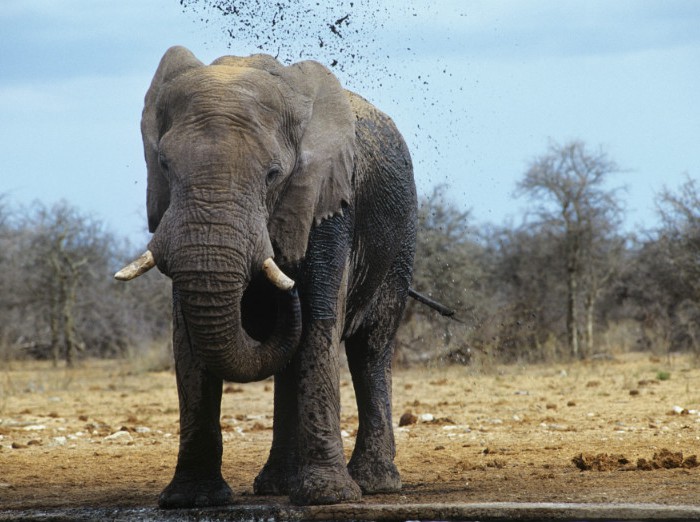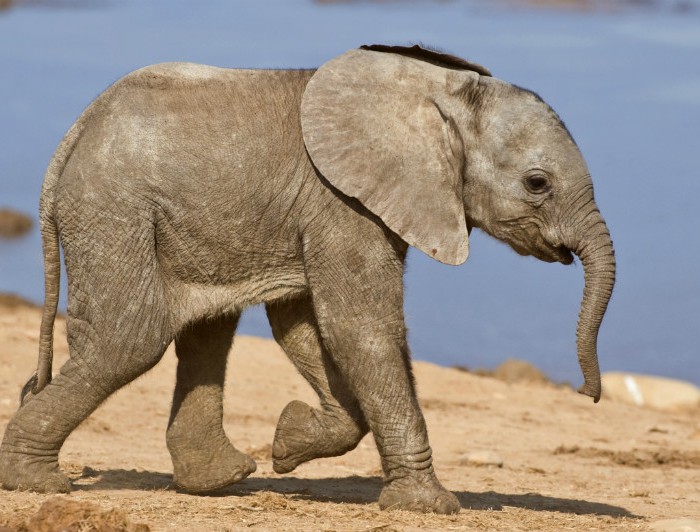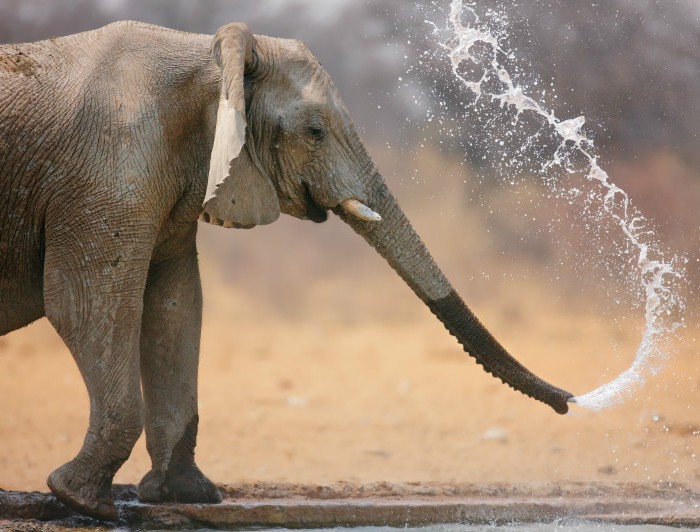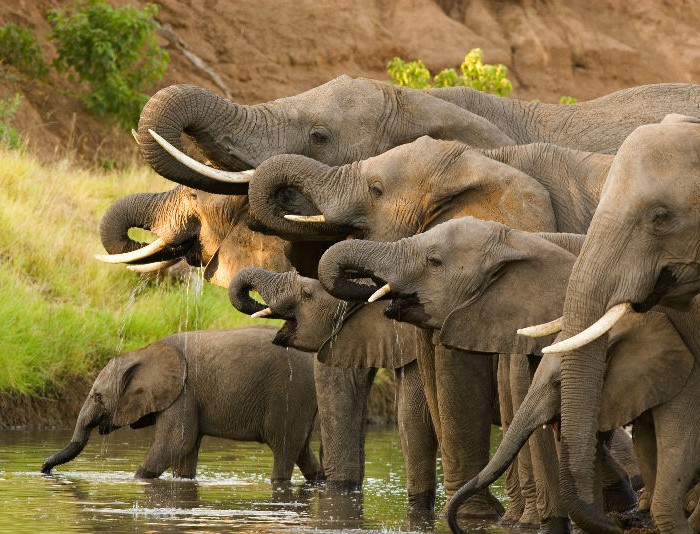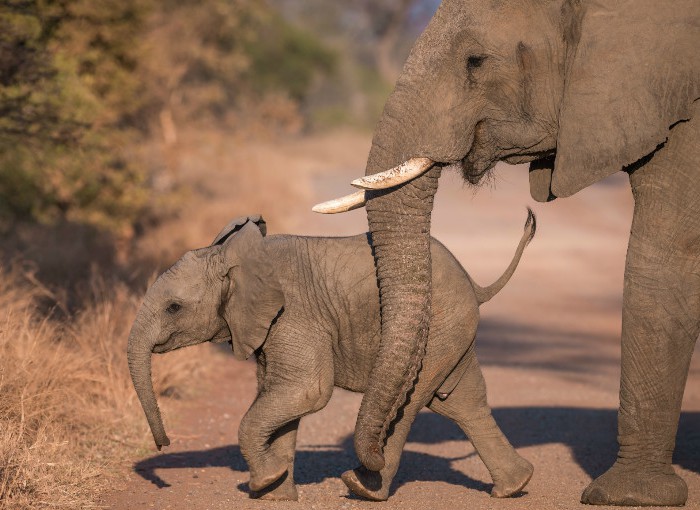
An elephant’s trunk is formed by the merging of the nose and the upper lip. The elephant trunk consists of over 100,000 muscles and tendons it serves many functions such as smelling, breathing, holding, touching and communicating.
It is strong enough to lift a baby elephant up a steep river bank and has the precision and dexterity required to pick a needle up from a flat surface. Vote for more elephant facts at African elephant and elephant’s teeth.
The elephant is one of the Big Five. To find out the other four animals that make up the Big Five please check out our article: 25 astonishing facts about Africa’s Big 5
Interesting facts about the elephant
1. Dexterity
The African elephant has two finger like projections at the end of its trunk. These are so sensitive and dextrous that it can pick up a needle from a flat surface.
2. Drinking
Elephants are fussy when it comes to their drinking water. They sometimes use their trunk to blow the scum off the surface before drinking and will often dig a small hole next to a main water source so clean water filters through.
3. Greeting
Elephants will greet each other by the lower ranked individual inserting its trunk in to the mouth of the other. This may be to swap chemical clues and could also be an act of respect.
4. Water capacity
An elephant can suck 4 litres of water into its trunk which it then squirts into its mouth to drink. It may drink 130 litres of water a day with a large bull taking in as much as 230 litres with the capacity to drink 100 litres in one go.
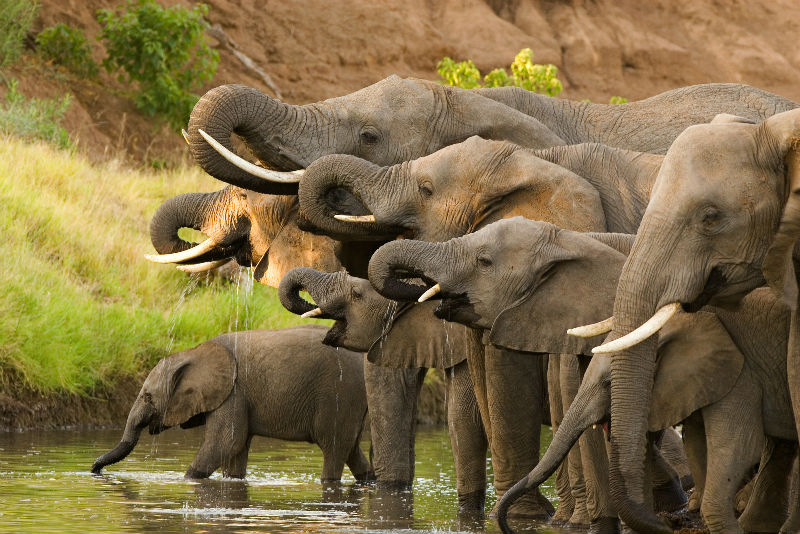
5. Trunk muscles
An elephant’s trunk which consists of over 100,000 muscles and tendons is formed by the merging of the nose and the upper lip.
6. Baby trunk
Elephants are born with a stunted trunk which rapidly elongates over a few days. However, it takes three months for the calf to master this complicated tool.
7. Trumpeting
Trumpeting is produced by the elephant blowing so hard through its nostrils that the trunk resonates.
8. Grieving
Elephants often use their trunk to sniff, pick up and move the bones of dead elephants in an act of grieving.
Frequently asked questions
- What is an elephant?
- Can elephants drink through their trunks?
- Do elephants breath through their trunks?
- What are trunks made of?
- What do elephants use their trunks for?
- How strong is an elephants trunk?
- Vote for your favourite fact
What is an elephant?
An elephant is the world’s largest land mammal that lives on the continents of Africa and Asia. They are unmistakable with their long trunk which fulfil a variety of uses including communication, bathing, drinking and feeding.
Can elephants drink through their trunks?
Elephants do not use a trunk like we would use a straw. Instead it sucks the water up its trunk, 4 litres at a time, which it then squirts into its mouth to drink.
Do elephants breath through their trunks?
Yes they do breath through their trunk. It is one very long nose with two nostrils like ours. You will often see an elephant with its trunk held up in the air moving around like a periscope as it tries to decipher smells. It’s sense of smell is extremely good.
What are trunks made of?
An elephant’s trunk consists of over 100,000 muscles and tendons. It is formed by the merging of the nose and the upper lip. There is no bone or cartilage in the trunk.
Made almost entirely of muscle, elephant trunks can lift hundreds of pounds, suck up gallons of water, and sniff out landmines. Video length: 3 minutes. Video source: Science Insider.
What do elephants use their trunks for?
The elephants trunk is a versatile tool. It is used for communicating, sucking up water to drink and shower, picking leaves and fruit off trees, for blowing and breathing. It can lift heavy objects and shake trees to dislodge fruit to eat or to weaken it before pushing it over.
How strong is an elephants trunk?
An elephant can lift a log weighing approximately 300kg with its trunk.
Vote for the fact you find most fascinating
The African elephant has two finger like projections at the end of its trunk. These are so sensitive and dextrous that it can pick up a needle from a flat surface.
Elephants are born with a stunted trunk which rapidly elongates over a few days. However, it takes three months for the calf to master this complicated tool.
Elephants will greet each other by the lower ranked individual inserting its trunk in to the mouth of the other. This may be to swap chemical clues and could also be an act of respect.
Trumpeting is produced by the elephant blowing so hard through its nostrils that the trunk resonates.
An elephant can suck 4 litres of water into its trunk which it then squirts into its mouth to drink. It may drink 130 litres of water a day with a large bull taking in as much as 230 litres with the capacity to drink 100 litres in one go.
Elephants are fussy when it comes to their drinking water. They sometimes use their trunk to blow the scum off the surface before drinking and will often dig a small hole next to a main water source so clean water filters through.
An elephant’s trunk which consists of over 100,000 muscles and tendons is formed by the merging of the nose and the upper lip.
Elephants often use their trunk to sniff, pick up and move the bones of dead elephants in an act of grieving.


